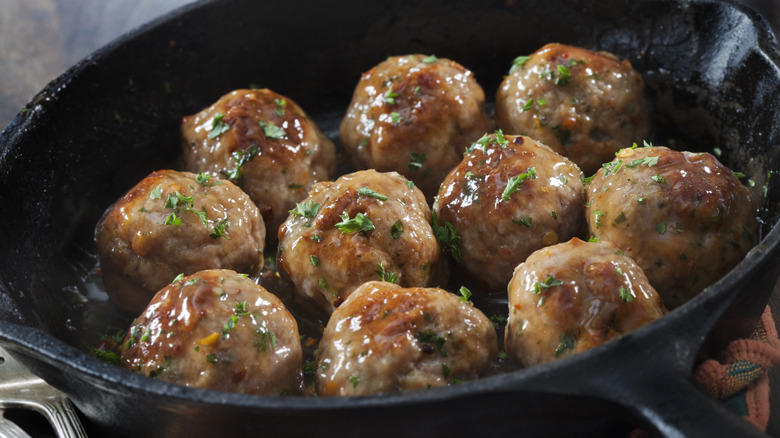Why You Need Dark Meat For The Juiciest Chicken Meatballs
Chicken meatballs are a lighter swap for the heavier pork-and-beef favorite. But when subbing chicken for red meat, it's all too easy to end up with a dry, unappetizing meatball due to the lack of fat content and milder flavor. The trick to ensuring your chicken meatballs are juicy, succulent, and bursting with chickeny flavor is to use dark meat, specifically ground chicken thighs.
Using dark meat in your ground chicken mix is essential to a moist and delicious final product. The fat in the dark meat helps keep the meatballs hydrated from the inside out, preventing drying. There's a reason why traditional meatball recipes typically call for 70/30 ground beef and often suggest including ground pork as well — which has roughly a 40% fat content. You also want to keep the skin of the chicken on if you're grinding your thighs at home, which will add additional fat and flavor.
Dark meat means fat and flavor
Dark meat or white meat: Which one is best? While some people prefer white meat over dark meat due to its lower calorie content and perceived healthiness, when it comes to making meatballs, dark meat is essential. Dark meat has a slightly higher fat content than white meat — about 3 grams more fat per 100 grams of meat. However, that's exactly what provides its richer flavor and slightly different texture.
Dark meat also has more nutrients than white meat and is higher in zinc and iron, though this doesn't impact flavor. If you're using any amount of white meat in your meatball recipe, be sure to cut it with at least a small amount of dark meat. All-white meat meatballs have a tendency to dry out quickly due to the lack of fat content. Ideally, though, use all dark meat in your recipe for the best possible results.
More tips for moist and delicious meatballs
Besides using dark meat, there are a few additional tips you can employ to keep your chicken meatballs from coming out dry. Another way to add moisture to a meatball mix is to whip up what's called a panade – a combination of (typically) bread and liquid, such as buttermilk or milk. Using fresh breadcrumbs and a fattier liquid, such as whole milk, helps to add an additional layer of creaminess to the meatballs once mixed in.
One more helpful tip: Don't overmix your meatballs. The more you mix, the more you overwork the meat. This will lead to a chewy, tough, unappetizing result. Mix lightly for the best soft, tender meatballs and avoid letting your mix become a paste in the process. Use your hands to mix the seasonings into the meat, or better yet, mix the panade with your seasonings first and then add everything together at the end, folding gently until just combined. Together, these tips will help your chicken meatballs turn out just as juicy as their beef or pork counterparts every time.


